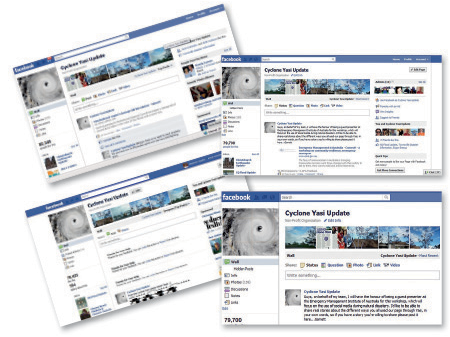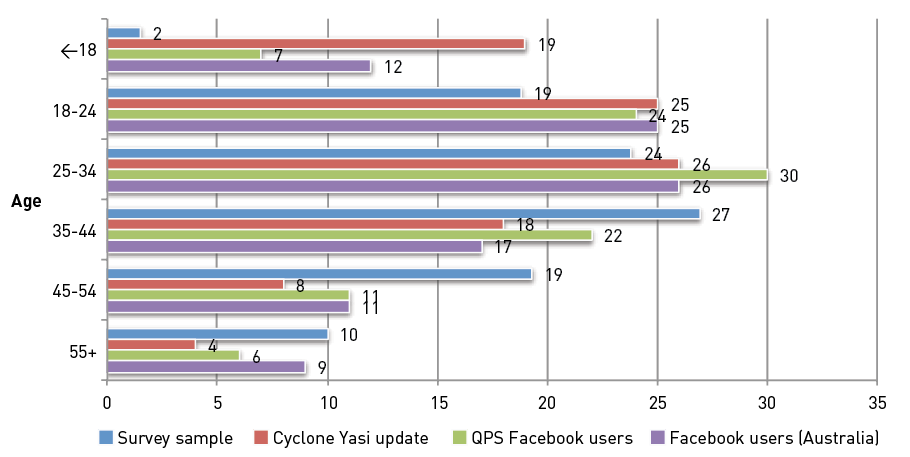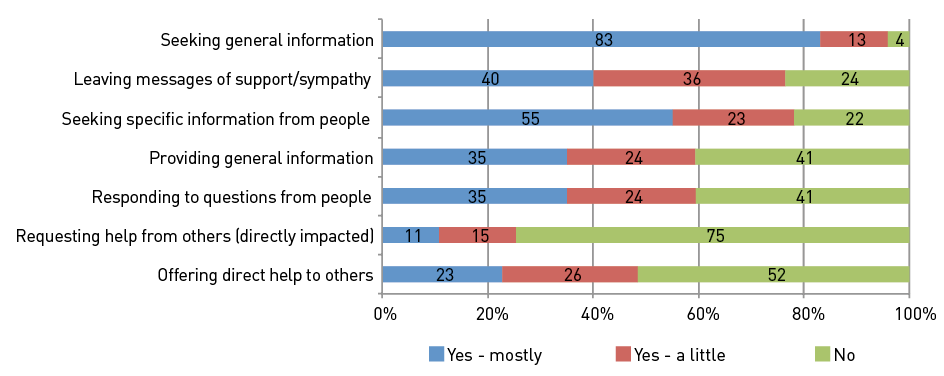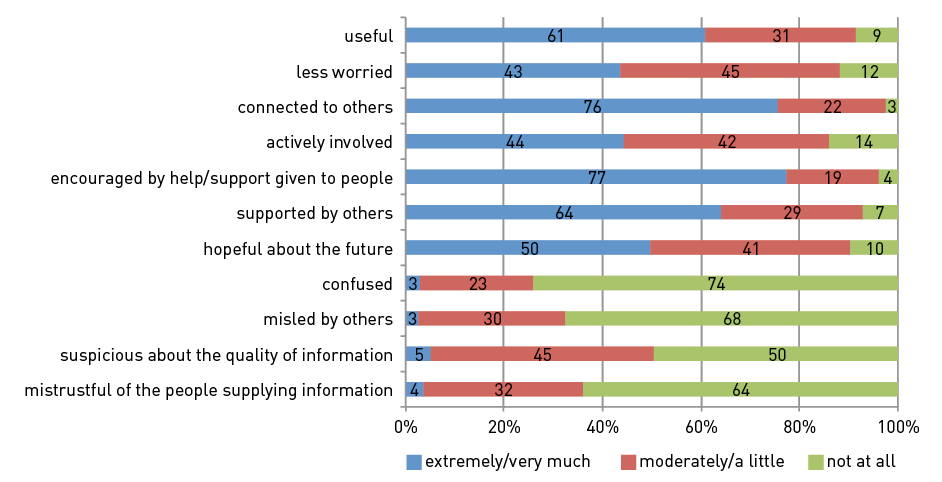The role of social media as psychological first aid as a support to community resilience building: a Facebook study from 'Cyclone Yasi Update'
Mel Taylor, Garrett Wells, Gwyneth Howell, Beverley Raphael
Peer-reviewed Article
Abstract
Article
Introduction
Social media are internet-based applications that enable people to communicate and share resources, e.g. Facebook, Twitter, YouTube, blogs, chat rooms (Lindsay, 2011). Social media are revolutionising communication and connections in all areas of life. The increasing use of ‘smart phones’ has been identified as an important factor enabling access to social media; most critically during and after disasters when landlines are often affected but mobile networks remain operational (White, 2011; Dufty, 2011). Two aspects of social media of particular relevance to their use in the context of natural disasters are their ability to provide access to timely public safety-related information from official and informal sources and their ability to enable connectedness; both to loved ones and to the broader community, providing reassurance, support and routes to assistance.
During the 2011 series of natural disasters in Australia, New Zealand and Japan, the importance of social media emerged sharply as a powerful communication channel for emergency management and response. The Queensland Police Service (QPS) demonstrated highly effective and well-supported social media engagement during the QLD floods and subsequent disasters, and their achievements in this area have been internationally recognised. Their ability to reach the population through the social media platform Facebook was dramatically evidenced by their Facebook ‘likes’ profile which rocketed from under 20,000 to over 160,000 within the three days of the flash flooding events in Toowoomba and the Lockyer Valley and during the period of rising flood waters in Ipswich and Brisbane (QPS, 2011).
In addition to Facebook pages run by a number of government agencies, councils, and NGOs during these disasters, a plethora of community-led pages was created across the affected communities; some focused on general information sharing and status reporting, e.g. closures of local roads, often accompanied by photographs, whereas others were set up for specific purposes, such as volunteering or fostering pets. The most widely used community-driven Facebook page was ‘Cyclone Yasi Update’ and this will be used as a case study here to discuss and support findings from an online Facebook-administered survey of social media use in disasters.

The changing 'face' of Cyclone Yasi Update as it tracked through the emergency.
Following a disaster individuals and communities may cope and recover in a variety of ways and via different trajectories. Two concepts that relate to response and recovery are the focus of this paper; psychological first aid (PFA) and community resilience (CR). PFA is now an established component of the psychosocial support delivered, as community-based activity, in response to disasters and emergencies. PFA outlines the first things you might do to assist individuals and families in the first hours following a disaster. It aims to reduce initial distress, meet current needs, promote flexible coping and encourage adjustment (Burke and Richardson, Australian Red Cross/Australian Psychological Society, 2009). PFA comprises six core principles; these are to promote safety, calm, connectedness, self- and group-efficacy, hope, and help. Further information is available from the Psychosocial Support in Disasters (PSID) portal, http://www.psid.org.au/.
Resilience is challenging to define due to lack of a single definition. Here we use the following definition, that resilience is “a process linking a set of adaptive capacities to a positive trajectory of functioning and adaptation after a disturbance” (Norris et al, 2008). In our context we are interested in community-level adaptation following disaster, as mediated through four main adaptive capacities which are the sets of resources thought to underpin community resilience. These are economic development, social capital, information and communication and community competence (Norris et al, 2011). Briefly, economic development refers to volume of resources, their diversity, and equity of distribution, with strengths arising from adequate economic resources, economic equity and minimising dependency on single industries or resources; social capital refers to the interconnectedness of individuals and organisations, in which strengths come through social support, sense of community and attachment to place. Information and communication in the context of disaster includes the need for accurate information to meet community needs but also includes the enabling of shared meaning and understanding of events and the ability of communities to share their stories and support a collective narrative. Community competence is the capacity for meaningful intentional action; the ability of communities to collaborate, form a working consensus, agree on a way to achieve goals and collaborate effectively on required actions.
The extent to which social media use in disasters can provide or support elements of psychological first aid and support the capacities that assist community resilience is an area that has not been addressed in the research literature to date. The exploratory survey reported here sought to assess a range of issues concerning use of social media in disasters. To assist emergency media and responder groups it sought to identify the social media ‘audience’ in disasters, to find out what they were doing in relation to these disasters, to explore their use and integration of information and their reliance on different sources of information. To support those in the health and disaster response and recovery areas, it also explored some of the psychological and affective components of social media use, and here, draws from the experience of the ‘Cyclone Yasi Update’ team to support these findings.
Case Study: Cyclone Yasi and the Facebook page ‘Cyclone Yasi Update’
Tropical Cyclone Yasi began forming near Fiji on 26 January 2011 and was named four days later. After progressively increasing in strength, it was confirmed as a Category 5 system on 2 February. With uncertainty over where it would make landfall, a large coastal section of Northern Queensland was on alert and with the State Premier urging people to evacuate, tens of thousands of people left the region. Residents in areas likely to be impacted were told by the State Emergency Coordinator that they would be on their own for up to 24 hours due to the dangerous conditions.
Media heralded Yasi as a cyclone that could be the worst in Queensland’s history; of greater severity than cyclones Larry and Tracy, one that could ‘annihilate’ the entire Queensland coast, with the energy of four Hiroshima bombs! Unsurprisingly, those who remained waited with trepidation and those who had left were deeply concerned for their neighbourhoods, friends, properties and belongings.
Against this backdrop the ‘Cyclone Yasi Update’ Facebook page was launched on 31 January. Initially conceived by Garrett Wells, it was based on an approach used in an earlier flood-related Facebook page ‘CQ Flood Update’, which provided communities in the Central Queensland (CQ) area with useful information and support. The rationale behind this page and similar area-specific ‘Update’ pages that followed was ‘helping people to help themselves’.
The full Yasi Update team comprised 12 ‘admins’; administrators and content managers recruited by Garrett, through earlier Facebook interactions. The team was geographically dispersed – from Merimbula in northern NSW to Cairns in northern QLD – and with a range of backgrounds and complementary skills; each member with his/her own social media networks and local knowledge.
From the outset, and somewhat different from many community-run disaster-related Facebook pages, Cyclone Yasi Update was coordinated as a disaster management ‘hub’; bringing together official information from many sources in a timely manner and combining that with two-way communication with people in the affected areas. This mix enabled the team to listen and correct inaccurate information, orientate people to the most helpful and relevant sources of official advice, ‘de-bunk’ rumours, and personalise information, if necessary, through direct contact. In doing so, they were able to provide a single initial trusted point of contact for people who needed to prioritise their activities to protect themselves, rather than spend time searching for information.
In addition to the provision of timely information, and the subject of this paper, the Cyclone Yasi Update team was able to provide psychological and emotional support to frightened and anxious people, and those doubting their ability to take effective action to protect themselves or their loved ones.
The success of the Cyclone Yasi Update page is reflected in its usage statistics. The member base reached 15,000 in the first 24 hours and grew to 92,299 at its peak on 2 February. On that day there were 509,743 direct page views, 3576 wall posts and almost 22.5 million ‘impressions’ (posts viewed on wall feeds).
Methods
Survey questionnaire development
The questionnaire was developed following a series of ten face-to-face interviews conducted in February 2011 in Toowoomba and Brisbane with individuals who had set-up and administered community Facebook sites relating to recent flooding events in Queensland, or who were active in posting to such sites. These interviews identified a range of issues related to social media use, use of information and motivation for becoming involved in using social media in disasters. In addition, survey questionnaire development was influenced by recent American Red Cross research which explored the use of social media in disasters and emergencies (American Red Cross, 2010); identifying the extent to which social media was being used to post eyewitness information and as a medium for requesting help from emergency response agencies.
The questionnaire comprised 27 questions, mostly multiple choice and many with multiple parts. The questions sought to investigate general use of social media in emergencies and disasters, use in recent disasters, identification of an ‘index’ event (the recent disaster for which social media had been used the most), use of social media and information sources in relation to this index event, and general demographic questions and questions around routine use of social media.
Survey administration
The survey questionnaire was hosted online using ‘survey monkey’ and the link was distributed using an uncontrolled (snowball) sampling technique. Access to the link was mostly driven via Facebook with an invitation and link posted on the most popular community Facebook pages for each of the recent major disasters. Subsequently, these links were re-posted and endorsed on ‘official’ government and response agency Facebook pages, e.g. Christchurch City Council, QPS, and the link was also forwarded to other social media platforms, such as Twitter. Participation in the survey was through self-selection.
Results
The survey link was sent out on 11 March 2011, three hours before the East Japan earthquake and tsunami. Within 36 hours 800 responses were received and when the survey link was closed on March 31st responses had been received from 1146 respondents.
Demographics
The majority of the sample was female (71%), 20% were male and 9% did not specify. In terms of their current situation, 60% were in employment, 17% were students, 11% were engaged in home duties, 4% were retirees and 2% were unemployed. Most respondents (81%) were living in Australia (50% in QLD, 23% in NSW and 8% other Australian states and territories). Of the remainder of the full sample, 8% were living in New Zealand, 3% were living overseas and 8% did not specify their residential location. Figure 1 shows the details of the age distribution of respondents in the survey. For comparison, these data are plotted against the age demographics of ‘Cyclone Yasi Update’ and QPS Facebook users and the Australian Facebook user population (Socialbakers, 2011). In the survey more than half the sample (51%) were in the 25-44 year age range, compared to 44% for Cyclone Yasi Update and 52% for QPS.
Figure 1. The age distribution of the sample (n=1057) compared to the age distribution of 'Cyclone Yasi Update' Facebook page, QPS Facebook page, and the Australian Facebook user population.

Use of information and information sources
Respondents were asked how likely they would be to go to different communication channels in the event of an emergency or disaster. As expected, a large proportion indicated they would be very likely to go to Facebook (75%), however, 85% would be very likely to go to TV News, 75% would go to online news and weather, and 56% would go to local radio. Just under a third (31%) said they would use Twitter. When asked the extent to which they would rely on social media or official sources of information, e.g. response agencies, the majority reported they would rely equally on both (56%), 38% would rely more on official sources and only 6% indicated they would rely more on social media sources of information.
When asked if they would do a range of actions to get help in an emergency or disaster if they couldn’t get through on triple zero (or 111 in New Zealand) more than half (52%) indicated they would be very likely to post a request on a response agency’s Facebook page, 18% would be very likely to send a message via Twitter to a response agency requesting help and 73% would be very likely to use social media to ask others to help them reach a response agency.
In relation to their nominated index event 91% of respondents indicated that they used official online sources of information; with 36% coming to these sources mostly by following links posted on social media and 37% coming to these official sources through a combination of social media links and their own searches.
Index events and what people were doing
Respondents were asked to nominate an index event for which they’d used social media the most and then answer more detailed questions in relation to that specific disaster event. Most of the sample (87%) clustered around five events; floods in Brisbane/Ipswich (38%), Cyclone Yasi (19%), flash flooding in Toowoomba/Lockyer Valley (19%), Christchurch earthquake (16%) and the Japan earthquake and tsunami (9%). In relation to all index events, 39% of respondents were directly affected and were living in the area/were there when the disaster happened, 32% had family or friends in the area of the disaster and only 11% had no connection to the place where the disaster occurred, so–called social media ‘tourists’. Overall, 57% of respondents were actively participating in social media in relation to their index event; posting messages, asking questions, providing information and 40% had more passive engagement; looking at information. A small proportion of respondents (3%) were actively involved in organising or administering a site or page. Figure 2 summarises what respondents were doing on social media and the extent of this activity.
Figure 2. What people were doing on social media, in relation to their nominated index event.

Finally, respondents were asked how their use of social media in relation to their index event made them feel. Figure 3 summarises these data.
Figure 3. How use of social media was making people feel.

Discussion
Comparing the survey sample demographics to user data collected by QPS and ‘Cyclone Yasi Update’, the sample distribution was similar in the 18-34 age categories, but was skewed slightly to older respondents, probably reflecting a greater willingness in the older age groups to complete an online survey. In terms of gender, the high proportion of female respondents (71%) reflects similar user figures for QPS (70%) and ‘Cyclone Yasi Update’ (76%), although it is over-representative compared to the Australian Facebook user population (54%). Given the lack of control over the sample, due to the sampling method, it was encouraging that 84% of the sample was from Australia and New Zealand, and that, when asked about their index event, that such a large proportion were either in the area where the event took place (39%) or had friends/family in the area (32%).
Data on the use of information and information sources clearly indicates that although social media are popular with this sample, there is still a strong interest for emergency information via traditional forms of media, especially television. It is also clear from the survey data that social media are acting as a conduit; orienting people to official sources of information and amplifying these messages to a broader audience. Compared to American Red Cross data (American Red Cross, 2011), Australian social media users would be more likely to post a request on a response agency’s Facebook page (52% c.f. 35%), less likely to send a message via Twitter to a response agency requesting help (18% c.f. 28%), and more likely to ask other people to help contact a response agency via social media (75% c.f. 44%). Although there are differences in the samples in these two studies, the results suggest that Australians would turn more readily to social media for help if ‘000’ or ‘111’ was not available.
The breakdown of what people were doing on social media also reflects, to an extent, their needs. Data suggest that most people were seeking information; either general factual information about what was happening, or directly asking people for specific information. More than a third of the sample was spending most of their time providing general information or responding directly to questions; explaining what was happening or directing people to further information. Around a quarter were using social media to request help. In support of others, around half were offering help or practical assistance and over three quarters were posting messages of support and sympathy. These patterns of activity are reflected in the experience of the ‘Cyclone Yasi Update’ team, with the supply of information, general and specific, forming the larger proportion of their activities, with the page providing a rallying point to enable and encourage page users to get people to help each other. Clearly, in the context of PFA principles, these activities promote safety, connectedness, self- and group-efficacy, and help, and in terms of community resilience, directly support the adaptive capacities of information and communication and help to bolster social capital, and community competence.
Perhaps stronger evidence for support of PFA principles through use of social media is provided by the breakdown of how the use of social media made people feel. Overwhelmingly people reported feeling a sense of connectedness and usefulness, felt supported by others and felt encouraged by the help and support being given to people. To a slightly lesser extent people reported feeling hopeful about the future, actively involved and less worried. These latter emotions probably reflect the realities of the disaster events, which were likely to involve a degree of loss and uncertainty about the future for themselves or their loved ones. In relation to experiences of the ‘Cyclone Yasi Update’ team, as Yasi was approaching people were increasingly more frightened and concerned about whether they had done enough to protect their properties and their families. One of the team said “people don’t want your sympathy they just want you to understand, and to ‘get’ what they’re going through.” To be able to say to someone in need, “I’m here, you’re not alone, I know I may be 800kms away from where you’re sitting - but I’m right here” and to have a conversation via social media can be a great source of comfort. Some of the Yasi team were themselves caught up in the storm, one team member based in Cairns posted updates from the floor of her bathroom where she was sheltering with her family.
Finally, along with the positive and supportive aspects of social media in disasters, it is important not to overlook the darker side of these media and their users. As Figure 3 showed, levels of reported negative emotional responses were generally much lower, and given that use of social media was voluntary, those who did not find involvement supportive or helpful were likely to opt-out. It is interesting to note that respondents in the survey displayed a moderate level of suspicion about the quality of information they were receiving and around a third reported feeling mistrustful of the people supplying information and misled by others. A healthy degree of suspicion is typical of social media users, and data from the survey indicate that few (6%) would rely solely on social media or unofficial sources of information. The ‘Cyclone Yasi Update’ team devoted a significant amount of time and effort correcting misinformation, countering rumours, validating the accuracy of information and dealing with ‘trolls’. A ‘troll’ is internet slang for those who provoke other users and disrupt discussion; posting off-topic or making inflammatory statements. To those who administer social media trolls are a considerable source of annoyance. To quote a member of the Yasi Update team, “these individuals delight in crushing goodwill and attempts to help others”. To maintain the integrity and protect trust in Facebook pages and other social media sites it is critical that trolls are banned quickly and those who seek to post information with ulterior motives, such as advertising or scamming, are identified early. Unfortunately, such issues have challenged many community-based social media sites, due to the level of vigilance and active management required, something made possible for ‘Cyclone Yasi Update’ by a large team and 24/7 monitoring at peak times.
Conclusions
The online survey data and experiences of the ‘Cyclone Yasi Update’ team provide strong evidence to support the assertion that use of social media in disasters can assist in the delivery of psychological first aid to those affected by disasters and support community resilience. The role of social media in this context is not to replace face-to-face support or contact, or to replace official warning services, but it can expand capacity to deliver information, extend the reach of official messages and limit the psychological damage caused by rumours and sensationalised media reporting. A mix and balance of official and informal information sources and communication channels is likely to be the best way to enhance emergency management capability. Empowering individuals and communities to help themselves through provision of accurate, timely and relevant information and a mechanism to connect with others are fundamental needs that social media can deliver. The dynamic and organic nature of social media is such that pages and sites take on a life of their own. Self-regulation and careful administration are elements that serve to ensure that the sites that succeed are those that listen and support the needs of their users.
Acknowledgements
The authors would like to acknowledge the members of the ‘Cyclone Yasi Update’ team: Andy Barber, Brett Campbell, Kylie Campbell, Melissa Capocchi, Cameron Hinezy, Andrew Hunter, Julie Just, Gareth Munro, Mark Murphy, Christopher Nicholls and Jenny Yates. The funding for this research was provided by Emergency Media and Public Affairs (EMPA) and the University of Western Sydney.
References
American Red Cross, 2010, Social media in disasters and emergencies. http://www.redcross.org/www-files/Documents/pdf/other/SocialMediaSlideDeck.pdf
Australian Psychological Society, 2009, Psychological preparation for natural disasters. http://www.psychology.org.au/Assets/Files/Psychological-preparation-for-natural-disasters.pdf
Burke S and Richardson J., 2010, Psychological First Aid: An Australian Guide. Joint publication of the Australian Psychological Society and Australian Red Cross. http://www.psychology.org.au/Assets/Files/Red-Cross-Psychological-First-Aid-Book.pdf
Dufty, N, 2011, Using social media for natural disaster resilience. Information Booklet. Molino Stewart, Parramatta, Australia. http://www.molinostewart.com.au/
Lindsay BR., 2011, Social media and disasters: current uses, future options, and policy considerations. Congressional Research Services Report 7-5700. http://fpc.state.gov/documents/organization/174191.pdf
Norris F, Stevens S, Pfefferbaum B, Wyche K and Pfefferbaum R, 2008, Community resilience as a metaphor, theory, set of capacities, and strategy for disaster readiness. American Journal of Community Psychology, 41: 127-150.
Norris F, Sherrieb K and Pfefferbaum B., 2011, Community resilience: concepts, assessment, and implications for interventions. In SM Southwick, BT Litz, D Charney, and MJ Friedman (Eds.) Resilience and Mental Health: challenges across the lifespan. Cambridge University Press, Cambridge, UK.
Psychosocial support in disasters http://www.psid.org.au/
Socialbakers, 2011, Australian Facebook User Statistics http://www.socialbakers.com/facebook-statistics/australia
QPS, 2011, Queensland Police Service Disaster Management and Social Media – a case study. http://www.police.qld.gov.au/Resources/Internet/services/reportsPublications/documents/QPSSocialMediaCaseStudy.pdf
White cm, 2012, Social Media, Crisis Communication, and Emergency Management; Leveraging Web 2.0 Technologies. CRC Press, Taylor and Francis Group, Boca Raton, US.
About the authors
Mel Taylor and Beverley Raphael are based in the Disaster Response and Resilience Research Group in the School of Medicine at the University of Western Sydney.
Gwyneth Howell is a specialist in Crisis Communication in the School of Communication Arts at the University of Western Sydney.
Garrett Wells was the lead administrator of the Cyclone Yasi Update Facebook site and is an Industrial Skills Trainer, based in Rockhampton, Queensland.


